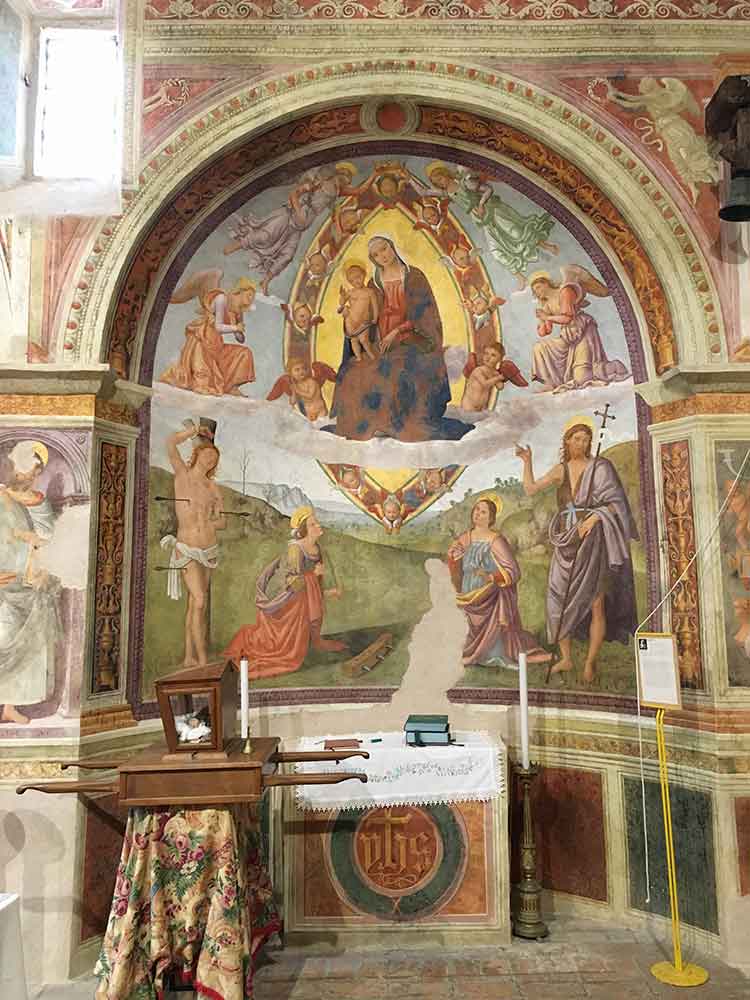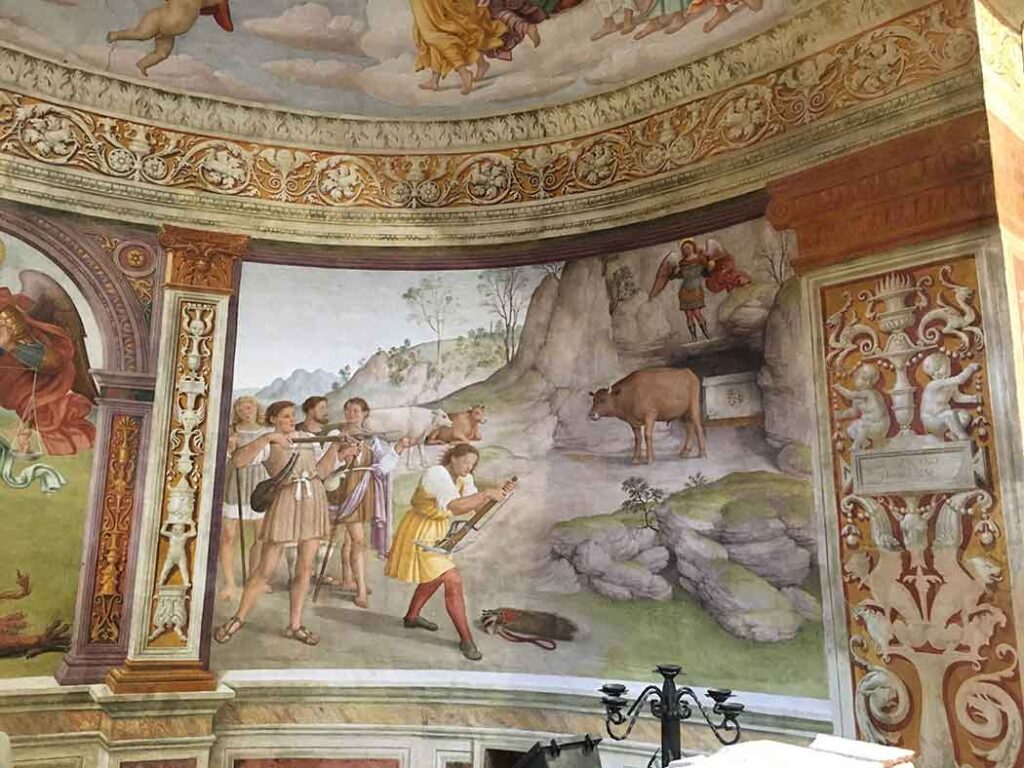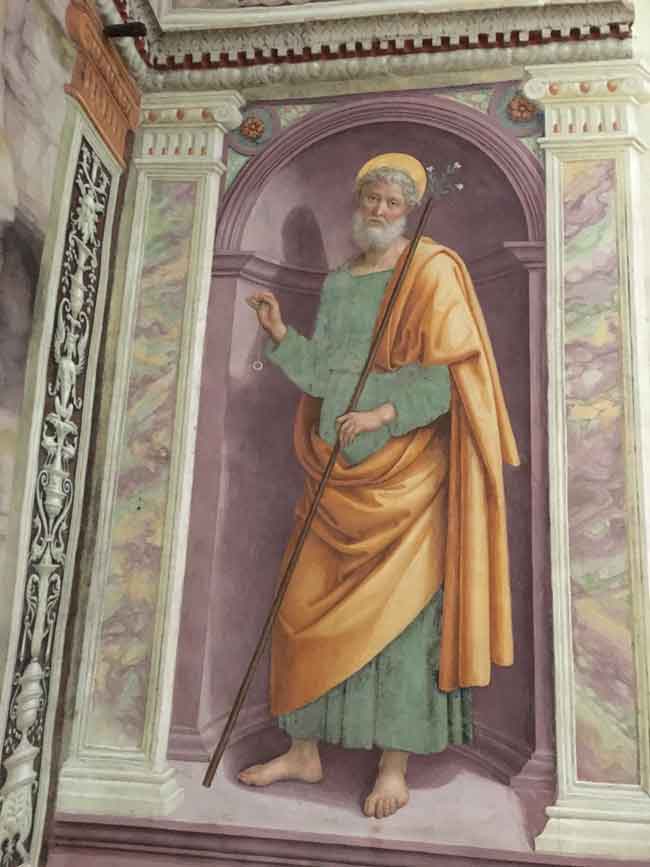Lo Spagna in Umbria
Discovering Lo Spagna in Umbria
Some may think me the adventurer. But it’s not true. Not that true anyway.
I’m not like others who are setting off to Reykjavík and sending back photos of windswept landscapes, cascading rivers, and smoldering earth. My adventures are decidedly more gentile, more civilized, if you will, and tend to be in search of wonderful art.
A few weeks ago I took some guests out for the day to Spoleto and environs. Cynthia and Dave, who’d stayed with me years earlier with another nephew, had brought Connor, in turn, on his first trip to Italy. The destination that day was the rocca above Spoleto so we parked beyond the moat and took the escalators, and then an elevator, to the summit. It was a beautiful day amidst too many rainy spring days so, as I had been there just the week before, I decided to browse the book store and then sit in the courtyard reading.
The book I purchased was dedicated to an artist I was only vaguely aware of, Giovanni di Pietro, called Lo Spagna. He was a contemporary of Perugino and Raffaello and had done quite a bit of work in Umbria. I was intrigued. According to the book, one of his greatest works was the frescoed interior of the church of San Michele in a small hill town somewhere in the direction of Norcia. The church had been recently restored, hence the beautifully enticing tome. By the time my guests returned, it had been added to my bucket list.
Now fast forward to today and my outing with fellow adventurers, Peter and Rixa. Since it was a long way away, and with no one to walk the dogs for me these days, Rocco and Puccini were also in tow. (Adventures these days are made all the more exciting because of my new FIAT with plenty of room for guests and dogs.)


Past Spello, Trevi, Clituno, and through the 4 kilometer tunnel toward Norcia we went. With little help from both the car’s TomTom (which I haven’t gotten the handle of yet) or Google maps on my phone, we were left to follow my relatively well-honed instincts. Finally spotting a sign for Gavelli just as I passed it (despite Google’s telling us to go eight more kilometers), I about faced and took the sharp turn before me.
Fraught with the self doubt to which anyone who disobeys a navigator is prone, I did my best to present as confident and put on the excited face of the adventurer. And onward we went. For some reason my mother’s driving advice came to mind— something along the lines of “all roads lead to home.” However, I knew that was of little help heading into the Sibillini National Park where we soon found ourselves on a narrow two lane road clinging to the side of a mountain. But as with all adventurers at the wheel, I oohed and aahed along with the others as we winded our way higher and higher.
Back in Bettona the day had begun with a light drizzle, but it was actually turning out to be quite nice with patches of blue breaking through while misty clouds still floated up from the surrounding forest. With each turn, the steep mountains —alternating thick with evergreens and then jagged outcroppings of stone — plunged into ravines out of sight below. Or so said Rixa who was on that side of the car. The road was in surprisingly excellent condition with its borders carpeted with poppies and brilliant wild flowers in purple, blue, and orange. Intensely yellow broom dotted the hills and, since this was a windows down drive, filled the car with its sweet scent. We rounded each bend with anticipation that was spectacularly rewarded.
Even with such natural beauty at every turn, after 20 minutes and having not passed a single car, it was getting difficult for me to keep up the façade of the cheerful explorer. Finally we came to a tiny outpost (three buildings) where two men were standing by their truck partly blocking the road. I asked if we were on the right road for Gavelli and they assured us it was up ahead. We set off again with renewed confidence and, as if God had intervened at last, a finally redirected Google app.
At last we reached the sign for Gavelli and we pulled off in the direction of a worn sign that said San Michele. Another left and then down a very steep road which, as soon as I did it, I realized was someplace I should probably not have tried to get the car down. We came to a stop at one of the most deserted places I’ve yet to discover. We left the car in the shade of a seemingly abandoned building with enormous wooden doors bolted shut and frozen in time. It was eerily quiet.
To the left, beyond a recently restored piazza with trough for washing clothes, the peeling stucco campanile of San Michele basked invitingly in the sun.
We all, dogs and people, after stretching a bit, ambled over to the church which was, you guessed it, locked.
“Oh well, it was the getting here that counts.” Rixa said.
My heart sank, Peter mumbled, and Rocco and Puccini busied themselves with new smells and finding places to pee.
A wooden gated side door offered a glimpse of the darkened interior with its low vaulted ceiling and a hint of one fresco. I was not about to give up without a fight. After all, we had just spent an hour in the car and were now in the middle of nowhere — albeit a spectacular nowhere.
With the leashed canines, I walked up the steep street along side the church and knocked at the first house that looked as if someone were home. (The key in the door was the tip off.) I put my request to the ancient signora who tentatively opened the door and stood silhouetted in the dark archway. She turned to say something to someone within and soon both she and her only slightly less ancient son made their way into the sunlight.



It seemed like the pair were straight out of Central Casting — she kerchiefed with two sweaters pulled over her apron and house dress and he in worn overalls, navy sweater, and cane. I swear there was even some straw clinging to his elbow. If it wasn’t Central Casting’s work, it was just about the most authentically rustic pair of mountain folk I had ever met.
I introduced myself and asked again if it were possible to see the church and frescoes and, having anticipated our request, he produced a suitably ancient looking key from his top pocket. I thanked the signora as Sergio, with the aid of his cane that seemed worn with having passed this way a thousand times, led us over to the church. The gate creaked open and he switched on the lights.
It was indeed spectacular and worth the trip.
I let the dogs off their leashes as the three of us (the people) began inspecting the frescoes. Lo Spanga was indeed very much like Perugino who I knew quite well living here for as long as I have. The recent restoration was evident in the crispness of the brightly painted pictures and intricate surrounding borders. I was glad we had not arrived 10 years earlier when the place was most probably on the verge of ruin. Many of the characters looked heavenly with the famous Perugino tilt of people who don’t look directly at God but instead give him sideways glances. Letting the art nerd in me completely come to the fore, I automatically went into “Identify the Saint” mode. To my delight this place was filled with saints – some old and some new friends.
In the first niche was Saint Jerome, an Umbrian favorite. The fresco was partly worn away on the sides but the central saint was beautifully illustrated with all the familiar attributes. Stone in hand, with his lion at his side and red cardinal’s hat nearby, Jerome looked heavenly toward a Madonna and child with angels. He was flanked by Anthony of Padua on the right and a badly deteriorated but easily recognizable San Francesco, in mid stigmata, on the left.
The top part of the next niche offered an odd and slightly gruesome Christ sliding into a sarcophagus complete with lots of details of his recent crucifixion. Along with the expected hammer, pincers, spear, hyssop, flagellation post and whip where a pair of disembodied heads, hands washing themselves, and hand with a sword over a recently cut off ear, and a black rooster. Beneath were an array of saints including two unidentified bishops, San Silvestro with his manacles, the elderly San Bernadino in his customary grey robes, Cassius of Narni whom I discovered a few years ago while exploring a church on the other side of Umbria, and a rather nonplussed San Sebastiano.
In the next niche I found God the Father enthroned above named but unfamiliar saints. (Lest I give you the impression that I know everything.) Below there was another San Sebastiano with fewer arrows, Saint Catherine of Alexandria with a very small part of her wheel, Saint Apollonia with her pincers and palm, and the unmistakable John the Baptist. Somewhere in between they managed to fit in an unnamed evangelist and, continuing the excess of devotion to the saint here in Umbria, yet a third Sebastiano.
Behind the altar, the top of the apse depicted the Virgin being crowned by her son surrounded by unidentifiable but presumably Old Testament characters, angels, and anatomically correct putti. Below were the best three panels spectacularly depicting Peter and Paul on the left, Michael holding his scales and spear atop a squirming devil in the center, and a very odd panel I hadn’t a clue about on the left. It was a group of young men in fashionably short skirts with crossbows preparing to shoot what looked like a domesticated bull. In the background Saint Michael appeared above a cave in which was a tomb labeled IHS. As I said, not a clue.
Between all of these niches were wonderfully painted pilasters, and panels using grotesques, vases, putti and other designs from the 15th century repertoire. The hands of subordinate artists could easily be seen in the different decorative styles and level of detail. Even in varying states of decay they were, none the less, all beautiful.
As I was turning my attention the the right wall of the church, I suddenly realized that Rocco and Puccini were no longer stretched out on the pavement and had instead opted for their own adventure. Outside, they were nowhere to be found so I rushed about calling. (I have long subscribed to the convention that I not name a dog anything I would be too embarrassed to call out over the neighborhood. Here, in Italy, we fit in just fine. “Poooocini! Roooccooo!” I called.)
Within a few minutes I found Rocco who, having supposed correctly that lunch was being served somewhere, had decided to beg at the door of the ancient signora. After 5 minutes out of daddy’s sight, he was happy to see me and came right away. Puccini refused to show up despite the urgency in my calls so I took Rocco to the car. Then, as I turned back toward the church, Puccini strolled into the little piazza with a “here I am” expression and happy to see me. Apparently pleased with his walk on the wild side, his little legs swiftly brought him to my side.
By the time I got back to the church, Sergio was locking up so I guess I will either never see the right wall or will have to find my way back. I thanked him again and asked how many people lived in the town.
“Right now 10 people live here.” He said, which I took to mean that either he wasn’t sure or that his mother was not much longer for this world.
Just then two men walked by and I asked if they lived there. The first said he was a worker but the second smiled and said he lived right there across from the church.
“So you’re one of the 10,” I said.
To which he replied, “Are there that many?”
With that, we set out in search of a town large enough to boast both a bathroom and trattoria.
— 9 June 2016


